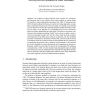SAM
2004
14 years 5 months ago
2004
This paper is a brief comparison between the Interactions of UML 2.0 as defined by the Final Adopted Specification (OMG ptc/03-07-06) and MSC-2000 as defined by Z.120 (ITU 1999). T...
APCCM
2006
14 years 5 months ago
2006
UML is posited as the "swiss army knife" for systems modelling and design activities. It embodies a number of modelling formalisms that have broad applicability in captu...
UML
2001
Springer
14 years 8 months ago
2001
Springer
Abstract. As the UML attempts to make the transition from a single, albeit extensible, language to a framework for a family of languages, the nature and form of the underlying meta...
ICFEM
2005
Springer
14 years 9 months ago
2005
Springer
Abstract. UML 2.0, which is the standard modeling language for objectoriented systems, has only an informally given semantics. This is in particular the case for UML 2.0 state mach...
EMSOFT
2005
Springer
14 years 9 months ago
2005
Springer
The recent release of UML 2.0 has corrected a lot of design diffi
DSVIS
2005
Springer
14 years 9 months ago
2005
Springer
Abstract. The ConcurTaskTrees (CTT) is one of the most widely used notations for task modeling, specifically tailored for user interface model-based design. The integration of CTT ...
EDOC
2005
IEEE
14 years 9 months ago
2005
IEEE
The advent of UML 2.0 has provided a new set of concepts more apt for modeling the structure and behavior of distributed systems. These concepts and mechanisms can be effectively ...
DATE
2005
IEEE
14 years 9 months ago
2005
IEEE
UML 2.0 provides a rich set of diagrams for systems documentation and specification. Many efforts have been undertaken to employ different aspects of UML for multiple domains, mai...
DATE
2005
IEEE
14 years 9 months ago
2005
IEEE
Unified Modeling Language (UML) 2.0 is emerging in the area of embedded system design. This paper presents a new UML 2.0 profile - called TUT-Profile - that introduces a set of st...
FASE
2007
Springer
14 years 10 months ago
2007
Springer
The synthesis of object behaviour from scenarios is a well-known and important issue in the transition from system analysis to system design. We describe a model transformation pro...



